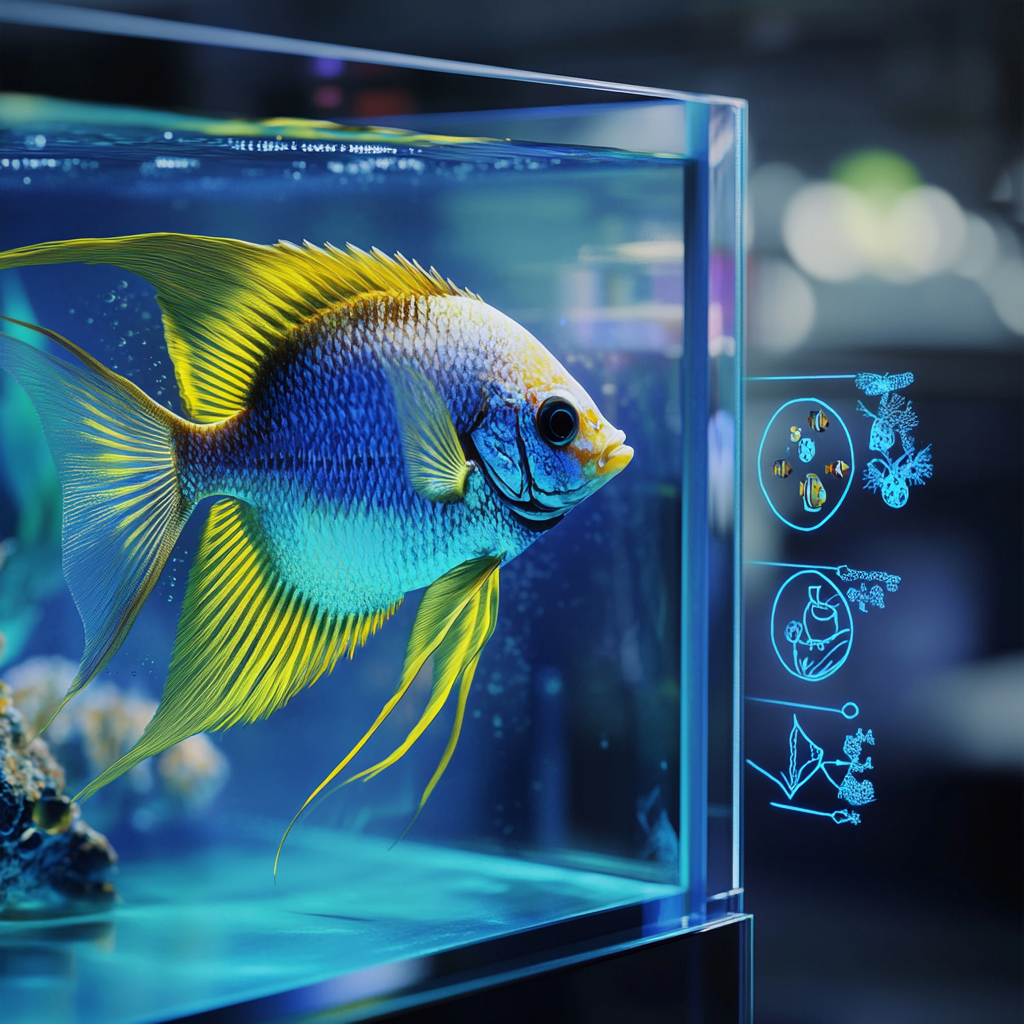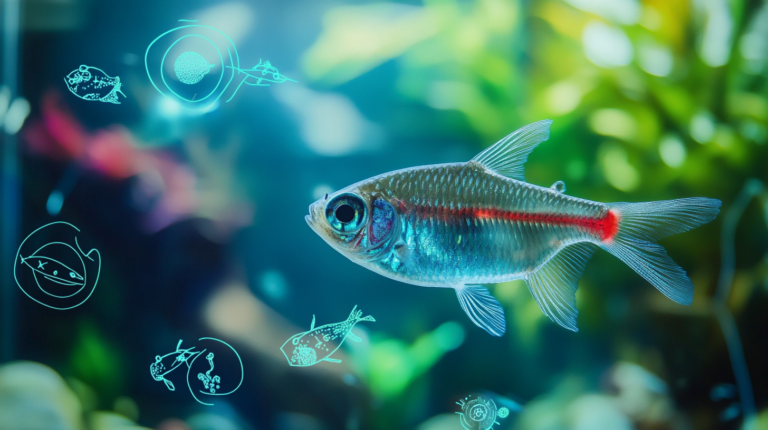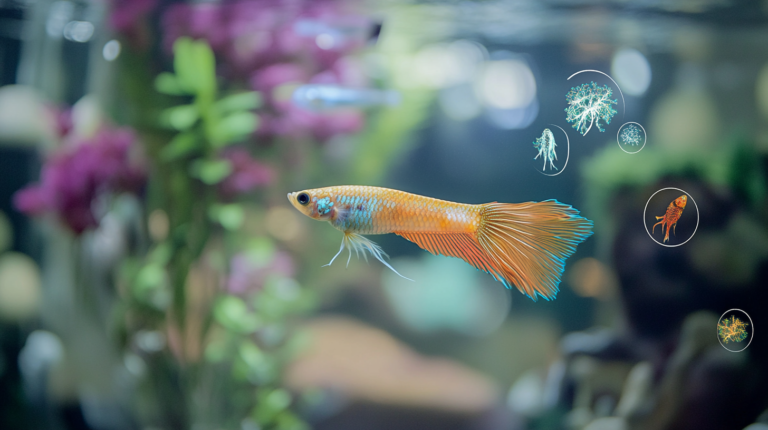Discover how to identify and treat fungal infections in fish quickly with our comprehensive guide to 6 common diseases, their symptoms, and effective remedies.
Table of Contents
Maintaining a healthy aquarium environment requires vigilance against various diseases, with fungal infections in fish being among the most common yet treatable ailments aquarists encounter. These infections typically appear as cotton-like growths on your fish’s body, fins, or mouth, signaling an underlying health issue that requires prompt attention. Whether you’re a seasoned fish keeper or new to the hobby, understanding how to identify, treat, and prevent fungal infections in fish is crucial for ensuring the longevity and wellbeing of your aquatic pets.
In this comprehensive guide, we’ll explore the six most common fungal diseases affecting aquarium fish, their causes, symptoms, and most importantly, how to treat them quickly and effectively before they spread to other tank inhabitants. With the right knowledge and quick action, you can help your fish recover and prevent future outbreaks in your aquarium.


Understanding Fungal Infections in Fish
What Are Fungal Infections?
Fungal infections are secondary opportunistic infections that typically affect fish already compromised by injury, stress, or poor water conditions. The fungi responsible are naturally present in most aquatic environments but only become problematic when they find a suitable host with weakened defenses.
These pathogens primarily belong to water molds (Oomycetes) like Saprolegnia and Achyla, as well as true fungi such as Ichthyophonus and Exophiala. When conditions are favorable for these organisms, they can quickly colonize a fish’s tissue, causing visible symptoms and potentially life-threatening complications if left untreated.
Why Fungal Infections Occur
Fish don’t typically develop fungal infections in optimal conditions. Several factors contribute to the emergence of these issues:
- Physical trauma: Wounds, scrapes, or fin damage create entry points for fungi
- Poor water quality: High ammonia or nitrite levels, incorrect pH, or fluctuating temperatures
- Overcrowding: Leads to stress and compromised immune systems
- Inadequate nutrition: Weakens the fish’s natural defenses
- Bacterial infections: Often precede fungal infections
- Stress: From transport, aggressive tankmates, or environmental changes
Understanding these contributing factors is essential not only for treatment but also for preventing recurrence of fungal infections in fish within your aquarium.
6 Common Fungal Infections in Fish and Their Treatments
1. Saprolegniasis (Cotton Wool Disease)
Symptoms
Saprolegniasis, commonly called “cotton wool disease,” is perhaps the most recognizable fungal infection in fish. It presents as:
- White to grayish cotton-like growths on the skin, fins, or gills
- Lethargy and loss of appetite
- Redness around infected areas
- Frayed fins if the infection affects the fin tissue
Causes
This infection is caused by water molds of the Saprolegnia genus, which are ubiquitous in freshwater environments. These opportunistic pathogens typically invade areas of the fish that have been previously damaged by:
- Physical injuries
- Parasitic infections
- Bacterial lesions
- Stress from poor water conditions
Treatment
Saprolegniasis responds well to early intervention:
- Salt baths: For mild cases, a salt bath (1 tablespoon of aquarium salt per gallon) can be effective
- Antifungal medications: Commercial treatments containing malachite green or methylene blue
- Potassium permanganate: Short baths at 10mg/L for 30 minutes (use with caution)
- Water changes: Perform a 25-30% water change before beginning treatment
Most cases show improvement within 3-5 days of consistent treatment, though complete recovery may take 1-2 weeks.
2. Branchiomycosis (Gill Rot)
Symptoms
Branchiomycosis specifically targets the gill tissue of fish, making it particularly dangerous as it directly affects respiration:
- Discolored, swollen gills (often brown or gray instead of healthy red)
- Rapid gill movement as fish struggle to get oxygen
- Fish gasping at the water surface
- Lethargy and decreased swimming activity
- Loss of appetite and weight
Causes
Caused by fungi of the Branchiomyces genus, this infection thrives in environments with:
- High organic waste
- Low oxygen levels
- Poor water circulation
- Overcrowding
Branchiomycosis is more common in ponds and densely stocked aquariums with inadequate filtration.
Treatment
Gill rot requires aggressive treatment due to its impact on respiratory function:
- Improve oxygenation: Add air stones or increase water movement
- Copper sulfate: In appropriate doses as directed by product instructions
- Malachite green baths: Short-term exposure following product guidelines
- Clean water: Daily partial water changes during treatment
Success rates depend on how early the infection is caught, with advanced cases having a poorer prognosis due to permanent gill damage.
3. Ichthyophonus Disease
Symptoms
Unlike most fungal infections in fish that present with external growths, Ichthyophonus primarily affects internal organs:
- Black or dark spots on the skin
- Erratic swimming behavior
- Protruding eyes (exophthalmia)
- Distended abdomen
- Emaciation despite normal feeding
Causes
Ichthyophonus hoferi is the primary pathogen, typically introduced through:
- Feeding infected live or frozen foods
- Introduction of infected fish to the aquarium
- Contaminated equipment
This systemic infection is particularly common in marine and coldwater species.
Treatment
Ichthyophonus is challenging to treat due to its systemic nature:
- Medicated food: Feed antibiotics like nitrofurazone or ketoconazole mixed with food
- Increased water temperature: Raising temperature slightly (within species tolerance) may help slow progression
- Isolation: Affected fish should be quarantined to prevent spread
The prognosis for Ichthyophonus is guarded, with recovery rates much lower than for external fungal infections. Prevention through quarantine of new fish and proper food sourcing is essential.
4. Egg Fungus
Symptoms
This specific fungal infection in fish affects eggs rather than adult fish:
- White, cotton-like growth on unfertilized or dead eggs
- Spread of fungus to adjacent healthy eggs
- Reduced hatch rates
- Cloudiness in egg masses
Causes
Egg fungus is primarily caused by Saprolegnia species that target:
- Unfertilized eggs
- Dead eggs
- Eggs in suboptimal water conditions
The infection spreads rapidly through egg clutches, potentially destroying entire spawns if not addressed.
Treatment
Protecting fish eggs from fungal infection requires preventative measures:
- Methylene blue: Add to hatchery water at low concentrations
- Hydrogen peroxide: Brief treatments at 150-300 ppm (use with extreme caution)
- Manual removal: Carefully remove infected eggs to prevent spread
- Increased water flow: Gentle water movement around eggs
With proper care, unaffected eggs can still develop normally, though overall hatch rates may be reduced.
5. Cotton Fin Disease
Symptoms
Though similar to Saprolegniasis, this variant of fungal infection in fish specifically targets fin tissue:
- White, fluffy growths primarily on fin edges
- Progressive fin erosion
- Redness at the base of affected fins
- Clamped fins and reduced swimming
Causes
Cotton fin disease is typically caused by various Saprolegnia or Achyla species and is often associated with:
- Prior fin damage from fighting
- Poor water quality
- Fin nipping from other fish
- Bacterial fin rot that creates entry points
Treatment
Addressing this condition requires both antifungal treatments and fin-specific care:
- Antifungal medications: Commercial products containing acriflavine or malachite green
- Salt dips: Short-term dips in salt solution (1-2 tablespoons per gallon)
- Clean water: Frequent water changes to maintain pristine conditions
- Vitamins: Adding vitamins to food can help with fin regeneration
With proper treatment, fin tissue can regenerate over 2-4 weeks, though severe cases may result in permanent fin damage.
6. Systemic Mycosis
Symptoms
This advanced form of fungal infection in fish occurs when fungi penetrate beyond the skin and gills into internal organs:
- Multiple external lesions or ulcers
- Discolored patches on the skin
- Swollen abdomen
- Loss of equilibrium
- Visible fungal growth in eyes or mouth
Causes
Systemic mycosis can be caused by various fungal species, including Exophiala and Phoma, and typically develops from:
- Untreated external infections
- Severely compromised immune systems
- Chronic exposure to poor water conditions
- Advanced age or underlying health issues
Treatment
Systemic mycosis has a poor prognosis but can be addressed with:
- Injectable antifungals: For valuable specimens, veterinary intervention with injectable medications
- Extended antifungal baths: Prolonged treatment with commercial antifungals
- Medicated food: Antifungal medications mixed with food
- Supportive care: Perfect water quality and supplemental nutrition
Recovery rates for systemic mycosis are low, with prevention and early intervention for simpler infections being the best approach.
Prevention of Fungal Infections in Fish
Water Quality Management
The single most important factor in preventing fungal infections in fish is maintaining excellent water quality:
- Regular testing: Monitor ammonia, nitrite, nitrate, pH, and temperature
- Filtration: Use appropriate filtration for your tank size and bioload
- Water changes: Regular partial water changes (25-30% weekly)
- Substrate cleaning: Regular gravel vacuuming to remove organic waste
- Avoid overstocking: Follow the inch-per-gallon rule appropriate for your species
Water Parameters Cheat Sheet:
| Parameter | Recommended Range | Testing Frequency |
| Ammonia | 0 ppm | Weekly |
| Nitrite | 0 ppm | Weekly |
| Nitrate | <20 ppm | Weekly |
| pH | Species-dependent | Weekly |
| Temperature | Species-dependent | Daily |
Quarantine Procedures
Implementing proper quarantine protocols prevents the introduction of fungal pathogens:
- Quarantine all new fish for 2-4 weeks before adding to main tank
- Observe for signs of disease during quarantine period
- Use separate equipment for quarantine tanks
- Consider prophylactic salt treatment during quarantine
Proper Nutrition
A well-fed fish with a balanced diet is more resistant to fungal infections:
- Feed high-quality commercial foods appropriate for your species
- Supplement with variety (frozen, live, or freeze-dried foods)
- Include foods rich in vitamins C and E to boost immune function
- Avoid overfeeding, which leads to poor water quality
Stress Reduction
Minimizing stress keeps your fish’s immune system functioning optimally:
- Provide appropriate hiding places and environmental enrichment
- Stock compatible species to avoid aggression
- Maintain stable water parameters without sudden changes
- Minimize tank disturbances and excessive noise
How to Quickly Spot Fungal Infections in Fish
Early detection is crucial for successful treatment of fungal infections in fish. Here’s what to look for during your daily observations:
Visual Inspection
- Morning check: Observe fish behavior and appearance when lights first come on
- Look for abnormalities: Any cotton-like growths, patches, or discolorations
- Fin condition: Check for clamped fins or unusual fin positions
- Gill movement: Rapid gill movement may indicate respiratory distress
Behavioral Changes
Changes in behavior often precede visible symptoms:
- Reduced activity: Lethargy or hiding more than usual
- Feeding changes: Decreased appetite or avoiding food
- Swimming patterns: Erratic swimming or difficulty maintaining position
- Surface gasping: Fish hanging at the water surface
Prevention Timeline
| Timeframe | Action |
| Daily | Visual inspection of all fish |
| Weekly | 25-30% water change and parameter testing |
| Bi-weekly | Equipment maintenance and filter cleaning |
| Monthly | Deep substrate cleaning |
| Quarterly | Replace filter media and check water hardness |
Treatment Options for Fungal Infections in Fish
Over-the-Counter Medications
Several commercial treatments are effective against fungal infections in fish:
- Malachite green: Effective against many fungal species (use as directed)
- Methylene blue: Particularly useful for egg fungus and mild infections
- Pimafix: Natural treatment containing pimenta extract
- API Fungus Cure: Combination treatment for fungal and bacterial infections
Natural Remedies
For those preferring natural approaches:
- Salt baths: 1-2 tablespoons of aquarium salt per gallon for 5-10 minutes
- Tea tree oil: Products containing diluted tea tree oil (follow package directions)
- Garlic-enhanced food: Boost immune function with garlic-infused food
- Aloe vera: Some evidence suggests aloe vera extract may have antifungal properties
When to Seek Veterinary Care
Some cases require professional intervention:
- Multiple fish affected despite treatment
- Severe or rapidly progressing infections
- Valuable or rare specimens
- Recurrent infections despite improved conditions
Recovery and Aftercare
Post-Treatment Monitoring
After treating fungal infections in fish, continue monitoring:
- Observe for signs of recurrence for at least two weeks
- Watch for secondary bacterial infections
- Monitor water parameters more frequently
Rebuilding Fish Health
Support recovery with:
- Vitamin-enriched foods
- Lowered light levels to reduce stress
- Slightly elevated temperatures (within species tolerance)
- Gradual reintroduction to normal feeding schedule
Recommended Pet Products on Amazon
Title: Recommended Pet Products on Amazon
- API FUNGUS CURE Fish Remedy: Effective treatment for fungal infections with malachite green and nitrofurazone
- Seachem Paraguard: Broad-spectrum treatment safe for scaleless fish and plants
- API AQUARIUM SALT: Essential for creating therapeutic salt baths
- Hikari Bio-Pure Freeze Dried Daphnia: Immune-boosting food supplement to aid recovery
Frequently Asked Questions
How quickly do fungal infections spread in aquariums?
Fungal infections can spread rapidly in suboptimal conditions, potentially affecting multiple fish within days. The rate of spread depends on water quality, fish density, and the underlying health of your fish. In overcrowded tanks with poor water parameters, an outbreak can affect most inhabitants within a week.
Can fungal infections in fish spread to humans?
Most fungal infections in fish are species-specific and pose minimal risk to humans. However, some water molds can cause minor skin irritation if you have open wounds while handling infected fish or aquarium water. Always wash hands thoroughly after aquarium maintenance and consider wearing gloves when treating infected fish.
How can I differentiate between fungal and bacterial infections?
Fungal infections typically present as cotton-like, fuzzy growths on the fish’s body, while bacterial infections often appear as red streaks, ulcers, or slimy patches. Fungal infections are usually white, gray, or slightly green, whereas bacterial issues tend to be redder in appearance. When in doubt, treat for both conditions, as many commercial medications address both pathogens.
Do all fish species have the same susceptibility to fungal infections?
No, susceptibility varies significantly between species. Cold-water fish like goldfish and koi are particularly prone to Saprolegnia infections, while certain tropical species such as bettas and gouramis are more resistant. Scaleless fish (like loaches and certain catfish) tend to be more vulnerable to all types of infections and require extra care during treatment.
Can plants in my aquarium get fungal infections too?
Yes, aquatic plants can develop fungal issues, though the pathogens are usually different from those affecting fish. Plant fungal problems typically appear as fuzzy growth on damaged leaves or stems. Maintaining good water flow, proper lighting, and removing decaying plant matter can help prevent plant fungal issues.
How long should I quarantine new fish to prevent fungal outbreaks?
A minimum quarantine period of 2-3 weeks is recommended, though 4 weeks is ideal. This timeframe allows for observation of potential disease symptoms and acclimation to your water parameters. During quarantine, consider prophylactic salt treatment at low concentrations (1 tablespoon per 5 gallons) to address any nascent infections.
Explore More Expert Pet Care Tips
Ready to become an expert in fish health and aquarium maintenance? Blithepet offers comprehensive guides on disease prevention, species-specific care, and creating the perfect aquatic environment for your finned friends. Our expert recommendations are based on years of aquarium experience and the latest research in fish health.
Discover our complete library of aquarium care articles and join our community of passionate fish keepers who are dedicated to maintaining thriving aquatic ecosystems.
Conclusion
Fungal infections in fish may be common, but with vigilant monitoring, proper tank maintenance, and swift intervention, they need not be devastating to your aquarium. By understanding the causes, symptoms, and treatment options outlined in this guide, you’re now equipped to protect your aquatic pets from these opportunistic pathogens.
Remember that prevention through excellent water quality and stress reduction is always preferable to treatment. However, should your fish develop fungal issues, early detection and appropriate medication will give them the best chance for a full recovery.
Have you dealt with fungal infections in your aquarium? Share your experience and tips in the comments below to help fellow fish enthusiasts tackle these challenging conditions.





